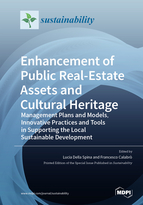Enhancement of Public Real-estate Assets and Cultural Heritage: Management Plans and Models, Innovative Practices and Tools in Supporting the Local Sustainable Development
A special issue of Sustainability (ISSN 2071-1050). This special issue belongs to the section "Tourism, Culture, and Heritage".
Deadline for manuscript submissions: closed (20 December 2019) | Viewed by 103516
Special Issue Editors
Interests: evaluation of the economic; environmental and social sustainability of plans and projects; according to an integrated and multidisciplinary approach
Special Issues, Collections and Topics in MDPI journals
Interests: Enhancement and management of cultural and environmental assets; Strategic Planning; Sustainability complex programs of urban transformation; Economic and financial feasibility of public and private investment; Governance of local development processes; Public Private Partnership
Special Issue Information
Dear Colleagues,
In recent years, new forms of enhancement of public real-estate assets and cultural heritage is one of the crucial challenges concerning the sustainable use of resources as an investment opportunity, based on research and innovation, dynamic way to stimulate preservation, development, renewal and transmission to future generations of these essential assets for development. The initiatives of local communities to regenerate abandoned spaces are increasingly widespread. Activities in the third sector, profit and non-profit associations, cultural and creative industries, start-up incubators, and crafts are just a few of the activities that are hosted in the enhanced assets. At the heart of these experiences is the desire to encourage economic and social innovation, while at the same time promoting synergy between public and private operators and supporting otherwise difficult development initiatives.
We invites researchers from different backgrounds, to exploring theoretical methodologies and/or presenting case studies deriving from different disciplines and approaches.
The reflections of researchers and scholars may address these topics from multiple perspectives. They may draw from specialized fields within geographic, economic, historic, cultural, architectural, social sciences and theory of decision.
The general aims of the special session are:
- Deeping the understanding of the role of cultural heritage valorization and public real-estate assets in local development processes;
- Increasing the dissemination of appraisal methods and systematic evaluation tools in the Heritage valuation and management fields;
- Providing decision-making support in the planning phase of heritage interventions;
- Improving the understanding of the dynamics, benefits, social and economic values of Heritage as a factor attracting innovation towards territory;
- Providing policy makers with possible solutions for heritage management as driver for local and sustainable management.
Prof. Dr. Lucia Della Spina
Prof. Dr. Francesco Calabrò
Guest Editors
Manuscript Submission Information
Manuscripts should be submitted online at www.mdpi.com by registering and logging in to this website. Once you are registered, click here to go to the submission form. Manuscripts can be submitted until the deadline. All submissions that pass pre-check are peer-reviewed. Accepted papers will be published continuously in the journal (as soon as accepted) and will be listed together on the special issue website. Research articles, review articles as well as short communications are invited. For planned papers, a title and short abstract (about 100 words) can be sent to the Editorial Office for announcement on this website.
Submitted manuscripts should not have been published previously, nor be under consideration for publication elsewhere (except conference proceedings papers). All manuscripts are thoroughly refereed through a single-blind peer-review process. A guide for authors and other relevant information for submission of manuscripts is available on the Instructions for Authors page. Sustainability is an international peer-reviewed open access semimonthly journal published by MDPI.
Please visit the Instructions for Authors page before submitting a manuscript. The Article Processing Charge (APC) for publication in this open access journal is 2400 CHF (Swiss Francs). Submitted papers should be well formatted and use good English. Authors may use MDPI's English editing service prior to publication or during author revisions.
Keywords
- Public Real-estate Assets
- Cultural Resources
- Sustainable Development
- Heritage Management
- Planning
- Real Estate Appraisal
- Economic Sustainability
- Bottom-up processes
- Profit and Non-Profit associations
- Cultural and creative industries
- Start-up incubators







